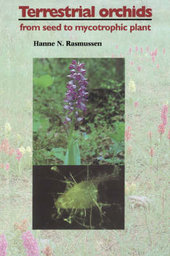
|
Terrestrial Orchids: From Seed to Mycotrophic Plant
Hardback
Main Details
| Title |
Terrestrial Orchids: From Seed to Mycotrophic Plant
|
| Authors and Contributors |
By (author) Hanne N. Rasmussen
|
| Physical Properties |
| Format:Hardback | | Pages:460 | | Dimensions(mm): Height 229,Width 152 |
|
| Category/Genre | Botany and plant sciences |
|---|
| ISBN/Barcode |
9780521451659
|
| Classifications | Dewey:584.15 |
|---|
| Audience | | Professional & Vocational | |
|---|
| Illustrations |
18 Tables, unspecified; 10 Halftones, unspecified; 30 Line drawings, unspecified; 18 Tables, unspecified; 10 Halftones, unspecified; 30 Line drawings, unspecified
|
|
Publishing Details |
| Publisher |
Cambridge University Press
|
| Imprint |
Cambridge University Press
|
| Publication Date |
24 August 1995 |
| Publication Country |
United Kingdom
|
Description
Terrestrial orchids have a wide appeal, but unfortunately they rank among the most vulnerable of all plant species, and little is known about how they reproduce in nature. This book contains a detailed survey of the biology of terrestrial orchids, from seed dispersal to establishment and life of the adult plant, based on comparisons of field and culture experiments. The unusual mode of obtaining energy by means of mycorrhiza is examined and evaluated in terms of plant structure and functions, and the impact of this mycotrophic nutrition on orchid evolution. The book makes it clear that an understanding of germination, life histories and seasonal phenology in natural habitats is essential for the success of culture methods, propagation and conservation. The final chapter is a systematic presentation of the life history, endophytes, and propagation of 36 genera of terrestrial orchids. Environmental plant physiologists will find this a stimulating book; for all those who are involved in orchid horticulture the book is indispensable.
Reviews'... fascinating as well as informative ... very much a book for the physiological botanist and those involved in the culture and preservation of terrestrial orchids. Many of you who just dabble in the subject may also find it enlightening and interesting.' The Journal of the Orchid Society of Great Britain 'Knowledge of orchid seed and seedling biology is essential to orchid conservationists, propagators and population biologists, and this book is an excellent reference volume.' Margaret M. Ramsey, Annals of Botany '... a well-written, thoroughly researched (600 references are cited) and useful book, which tackles the complexity of the subject lucidly ... provides abundant theoretical and practical advice to the orchid propagator.' A. J. Richards, Experimental Physiology 'This work must surely be regarded as the definitive study on orchid fungal associations (mycorrhiza) to date ... this scholarly work comes highly recommended, especially to those who like to know a little more than one finds in the average book on orchids ... you will spend many hours fascinated by the contents of this book.' Gavin J. McDonald, South African Orchid Journal ' ... a valuable resource. The text is packed with information, logically presented, and highly readable - an amazing accomplishment.' D. H. Firmage, Israel Journal of Plant Sciences 'For those growers seeking a challenge, and for those researchers interested in pursuing the intricate relationships between fungus and orchid, cultivation of terrestrial orchids provides a significant challenge. Those persons will find Rasmussen's insightful writing and thorough explication of the associations between these organisms the sine qua non for intelligent attempts to grow terrestrial orchids ... Anyone seriously interested in terrestrial orchids, their development, mycotrophy, ecology, and cultivation can ill afford not to use Hanne Rasmussen's book as a vade mecum.' William Louis Stern, University of Florida, HortScience ' ... research workers entering this area of science for the first time will find this a very useful introduction to the subject.' Hugh Pritchard, Seed Science Research 'Concise and well arranged ... the author steers a careful course between the purely academic biological textbook and the laboratory manual, and in my view has been extremely successful in bridging the two with a work that will be widely consulted by botanists, ecologists, horticulturalists and conservationists ... indispensable for the orchidologist and specialist grower...' Phil Lusby, The New Plantsman
|